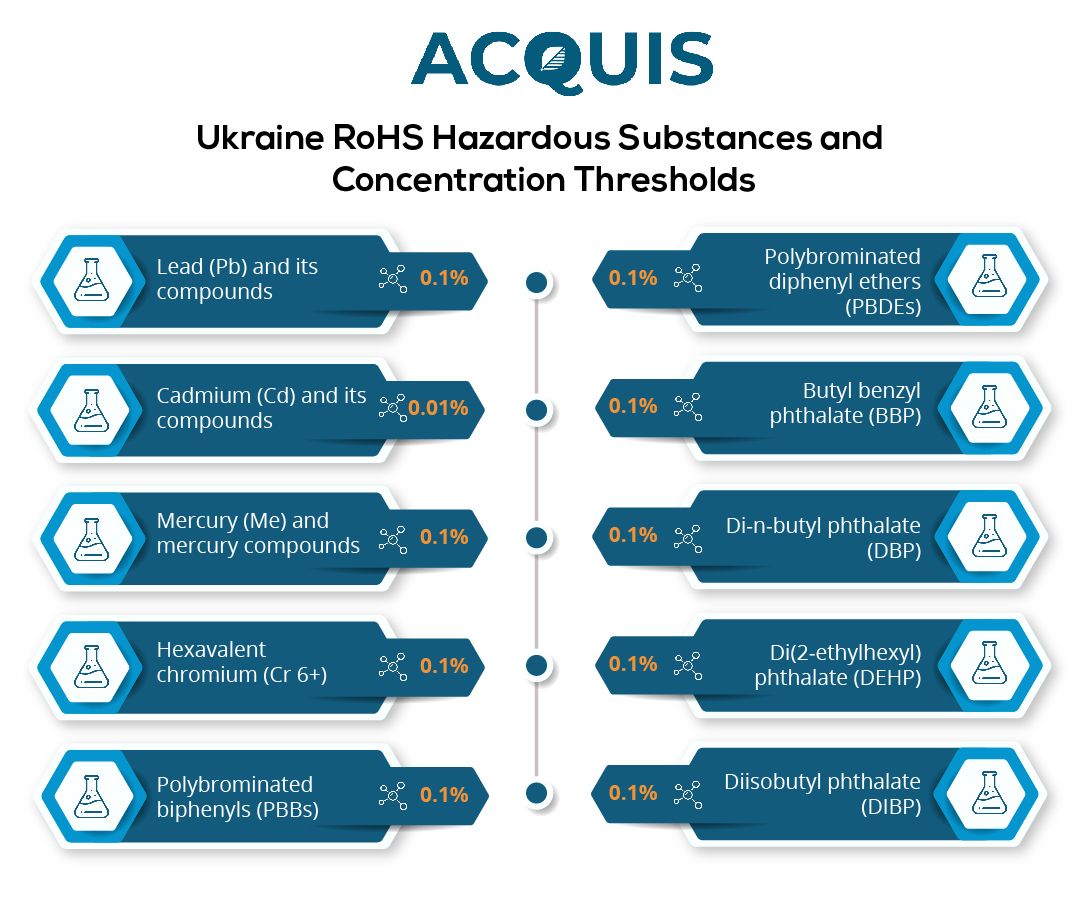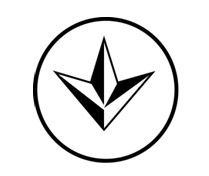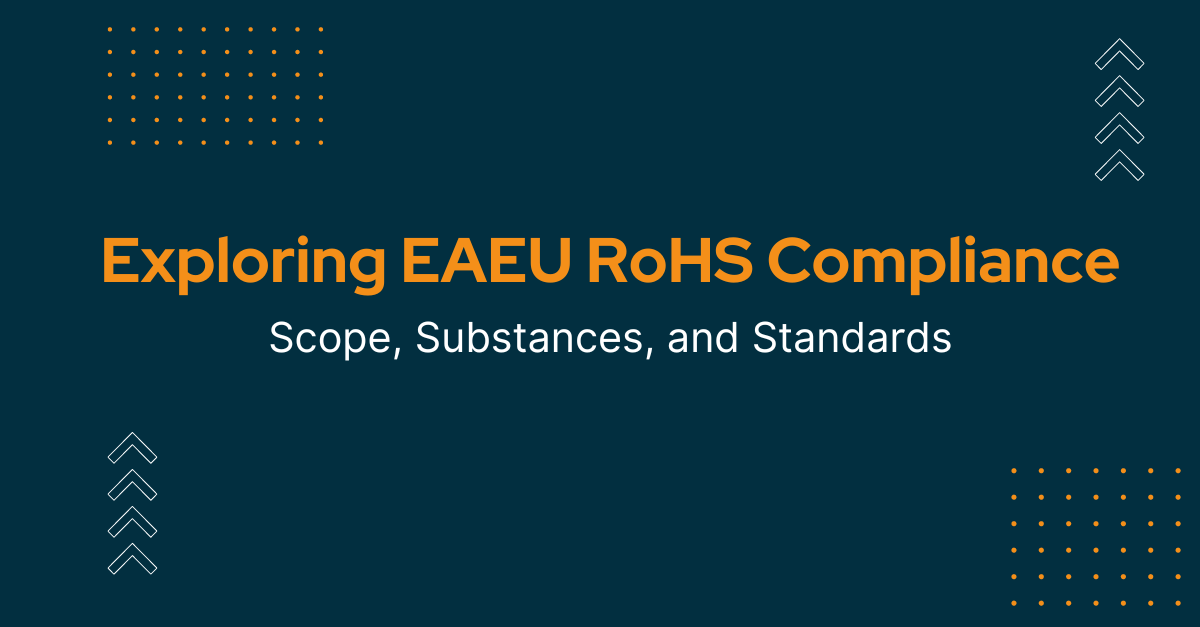Ukraine's version of RoHS, officially known as the Ukrainian Technical Regulation on the restriction of hazardous substances in electrical and electronic equipment, came into effect on September 22, 2017. This regulation aligns with the existing EU RoHS directive. Manufacturers importing electrical and electronic equipment (EEE) to Ukraine must ensure that their products are compliant with Ukraine’s ROHS directive. For medical devices and controlling & monitoring instruments, RoHS compliance commenced on January 1, 2018, allowing for a grace period.
Key obligations for manufacturers include retaining records of non-compliant EEE and product recall details. Proper marking of EEE indicating compliance with RoHS requirements is now mandatory. In cases where EEE on the market does not meet this requirement, manufacturers must notify Ukrainian governmental agencies, potentially leading to further actions to address non-compliance.
Ukraine RoHS limitation of usage of certain hazardous substances in electric and electronic equipment
The regulatory journey began on December 3rd, 2008, when the Cabinet of Ministers of Ukraine introduced Decree no 1057, titled 'Regulation on limitation of usage of certain hazardous substances in electric and electronic equipment.' A significant milestone occurred on March 17th, 2017, with amendments that included the addition of four phthalates to the RoHS material list, aligning Ukraine RoHS more closely with the European Union version. This amended version, now known as Ukraine RoHS under Decree no 139, replaced its predecessor, Decree no 1057.
The restricted compounds comply with EU RoHS and include lead, cadmium, mercury, hexavalent chromium, PBB, and PBDE. In addition, particular phthalates have been subject to a phased-in limitation. Beginning January 1, 2018, DEHP and BBP were subject to limits in specific applications, such as toys. Subsequent limitations on DEHP, BBP, DBP, and DIBP were planned for various categories, with universal applicability to all EEE by July 22, 2021.
The Scope of Ukraine RoHS
Ukraine RoHS mirrors the scope of EU RoHS, encompassing a broad spectrum of electronic and electrical equipment. From large appliances to medical devices, the ROHS regulation in electronics ensures a comprehensive approach to environmental responsibility. Notably, batteries are excluded from RoHS standards, with separate legislation guiding their compliance. The applicable categories include:
- Large appliances
- Small appliances
- IT and telecommunications equipment
- Household electronics
- Lighting equipment
- Electrical and electronic tools
- Toys, leisure, and sports equipment
- Medical devices
- Monitoring and control devices
- Automatic dispensers
- Other equipment not covered by the previous categories
The aim is to ensure the responsible management of substances like Lead, Cadmium, Mercury, Hexavalent Chromium, PBB, and PBDE, promoting environmental sustainability and safeguarding human health. Similar to the EU RoHS directive, batteries are not within the scope of Ukraine's RoHS electronic component regulations. Separate legislation typically governs batteries and accumulators, emphasizing a targeted regulatory approach for these specific components. Compliance with these regulations is essential for manufacturers to meet environmental standards and market requirements in Ukraine.
Hazardous Substances and Concentration Thresholds of Ukraine RoHS

Ukraine's RoHS regulations also impose restrictions on ten hazardous substances in electrical and electronic equipment (EEE). These substances and their concentration thresholds are as follows:
- Lead (Pb) and its compounds
- Cadmium (Cd) and its compounds (with a more restrictive threshold of 0.01%)
- Mercury (Me) and mercury compounds
- Hexavalent chromium (Cr 6+)
- Polybrominated biphenyls (PBBs)
- Polybrominated diphenyl ethers (PBDEs)
- Butyl benzyl phthalate (BBP)
- Di-n-butyl phthalate (DBP)
- Di(2-ethylhexyl) phthalate (DEHP)
- Diisobutyl phthalate (DIBP)
The concentration thresholds for these substances must not exceed 0.1%, except for cadmium, which has a stricter limit of 0.01%. Ukraine's RoHS includes exemptions to these restrictions. Interestingly, it adopts the same RoHS exemptions as the EU.
Ukraine RoHS Exemptions and Declaration of Conformity
The Declaration of Conformity (DoC) for Ukraine's RoHS regulations is a mandatory document for manufacturers and importers of electrical and electronic equipment (EEE). Similar to EU RoHS, the DoC must be drafted in Ukrainian, and if initially completed in another language, a translated copy in Ukrainian is required. In the case of a RoHS certificate of compliance, a mark must be placed in a conspicuous location on the product. This marking follows the guidelines outlined in Decree no 1184, specifically the "description of a conformity sign to technical regulations, rules and conditions of its drawing."
The Declaration of Conformity (DoC) in the context of Ukraine's RoHS regulations involves key aspects:
- Exemptions and Compliance Details:
- The declaration may specify exemptions applied to the product, with manufacturers justifying the use of restricted substances based on regulatory exemptions.
- Compliance details, including adherence to specific standards or testing methodologies, may be outlined in the declaration.
- Verification and Signatory:
- The DoC typically requires a responsible party, often the manufacturer or an authorized representative, to sign and attest to the accuracy of the information provided.
- The designated signatory should have the authority to make declarations on behalf of the manufacturer, emphasizing accountability and responsibility.
UkrSEPRO: The Conformity Mark
UkrSEPRO is a national conformity assessment system in Ukraine, designed to ensure that products meet specific safety and quality standards. This certification is obligatory for a diverse array of products, ranging from electronics to industrial machinery. Compliance extends beyond documentation; a visible mark is crucial. In this case, it's the UkrSEPRO conformity mark, distinct from the EU CE marking. Its placement adheres to the guidelines of Decree no 1184, serving as a clear indication of compliance with technical regulations.

The determination of the certification type is governed by a specific ordinance, which categorizes products based on their nature.
- Mandatory Certification:
For products falling under mandatory certification, compliance is not optional; it's a requirement. These products must obtain UkrSEPRO certification on a mandatory basis, and the foundation for this certification lies in a test report from an accredited laboratory. This stringent process ensures that essential safety and quality standards are met.
- Voluntary Certification:
In cases where a product is not obligated to undergo mandatory certification in Ukraine, businesses have the option to pursue voluntary certification. This choice, made to enhance competitiveness, allows products to bear the UkrSEPRO conformity mark on a voluntary basis. Notably, not all products necessitate testing, offering flexibility achieved through product certification plans.
Implications of Ukraine's Adoption to DSTU EN IEC 63000:2020
DSTU EN IEC 63000:2020 or ДСТУ EN IEC 63000:2020 refers to a Ukrainian standard that aligns with the European standard EN IEC 63000:2018. DSTU stands for "Derzhavnyy Standart Ukrayiny" in Ukrainian, which translates to "State Standard of Ukraine." EN refers to the "European Norm," and 63000 is a IEC (International Electrotechnical Commission) standard number. Let's break down the information:
- DSTU EN IEC 63000:
This indicates that the standard is a Ukrainian national standard (DSTU) that aligns with the European standard EN IEC 63000.
- Year 2020:
This denotes the year of adoption or publication of the Ukrainian version of the standard.
- EN IEC 63000:2018:
This is the European standard that serves as the basis for the Ukrainian standard. The "EN" signifies that it is a European standard, and "IEC 63000" is the standard number. The year 2018 denotes the year of adoption or publication of the European standard.
<u>Key Changes</u>
-
DSTU EN IEC 63000:2020 Supersedes DSTU EN 50581:2014: The most significant change is the adoption of DSTU EN IEC 63000:2020 as the new standard for demonstrating compliance with the Ukrainian RoHS Technical Regulation. This standard replaces the previously used DSTU EN 50581:2014.
-
New Test Reports Required: To comply with the updated regulations, manufacturers will now need to obtain test reports based on the EN 63000:2020 standard. These reports will serve as evidence that their products meet the Ukrainian RoHS restrictions on hazardous substances.
-
Previously Issued Documents Remain Valid: It's important to note that existing RoHS DoCs (Declarations of Conformity) referencing compliance with the older DSTU EN 50581:2014 standard will still be considered valid. Companies won't need to update these documents unless there are other changes to their products.

Conclusion - Adhering to evolving environmental regulations is essential for businesses. Understanding and complying with Ukraine's RoHS regulations not only ensures legal conformity but also underscores a commitment to environmental responsibility. Stay informed, subscribe to relevant newsletters, and navigate the intricate world of environmental regulations with confidence.
Speak to Our Compliance Experts
Share
ENVIRONMENTAL COMPLIANCE
- RoHS
- SCIP (WFD)
- REACH
- California Proposition 65
- Material Disclosure (FMD)
- PFAS
- TSCA PBT
- EU POPs
- EU MDR & IVDR
- ELV (GADSL)
- Others
- Extended Producer Responsibility (EPR)
INTEGRATION SUPPORT
WE ARE GLOBAL
USA
6705 Ridgedale CT, Glen Allen, VA 23059
+1.757.801.2760
info@aquiscompliance.com
India
#9/2, Hennur Bagalur Main Road, Bengaluru - 560077
+91 789 238 1827
info@aquiscompliance.com



